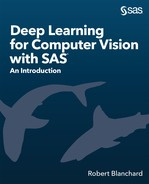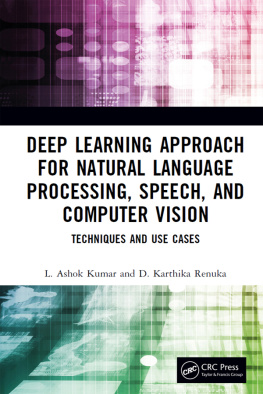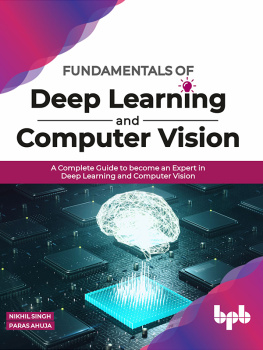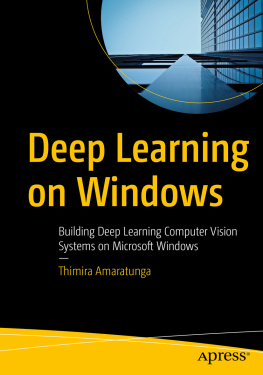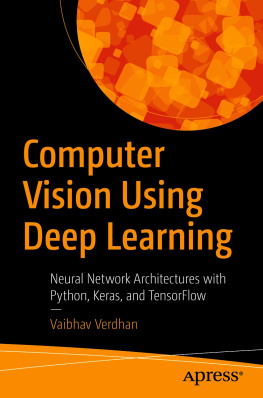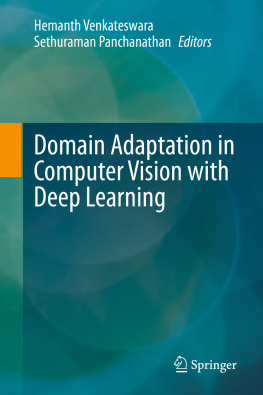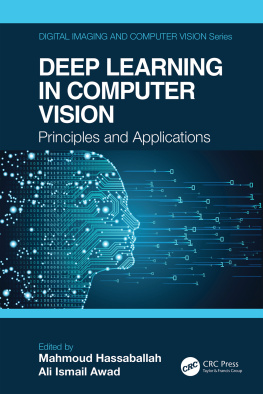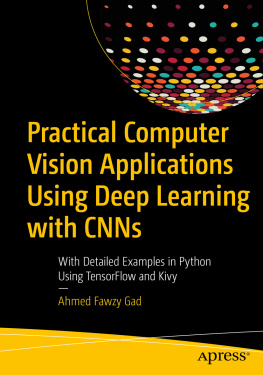Robert Blanchard - Deep Learning for Computer Vision with SAS
Here you can read online Robert Blanchard - Deep Learning for Computer Vision with SAS full text of the book (entire story) in english for free. Download pdf and epub, get meaning, cover and reviews about this ebook. year: 2020, publisher: SAS Institute, genre: Romance novel. Description of the work, (preface) as well as reviews are available. Best literature library LitArk.com created for fans of good reading and offers a wide selection of genres:
Romance novel
Science fiction
Adventure
Detective
Science
History
Home and family
Prose
Art
Politics
Computer
Non-fiction
Religion
Business
Children
Humor
Choose a favorite category and find really read worthwhile books. Enjoy immersion in the world of imagination, feel the emotions of the characters or learn something new for yourself, make an fascinating discovery.
- Book:Deep Learning for Computer Vision with SAS
- Author:
- Publisher:SAS Institute
- Genre:
- Year:2020
- Rating:5 / 5
- Favourites:Add to favourites
- Your mark:
- 100
- 1
- 2
- 3
- 4
- 5
Deep Learning for Computer Vision with SAS: summary, description and annotation
We offer to read an annotation, description, summary or preface (depends on what the author of the book "Deep Learning for Computer Vision with SAS" wrote himself). If you haven't found the necessary information about the book — write in the comments, we will try to find it.
Deep Learning for Computer Vision with SAS — read online for free the complete book (whole text) full work
Below is the text of the book, divided by pages. System saving the place of the last page read, allows you to conveniently read the book "Deep Learning for Computer Vision with SAS" online for free, without having to search again every time where you left off. Put a bookmark, and you can go to the page where you finished reading at any time.
Font size:
Interval:
Bookmark:
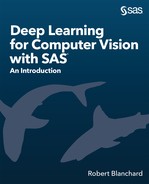
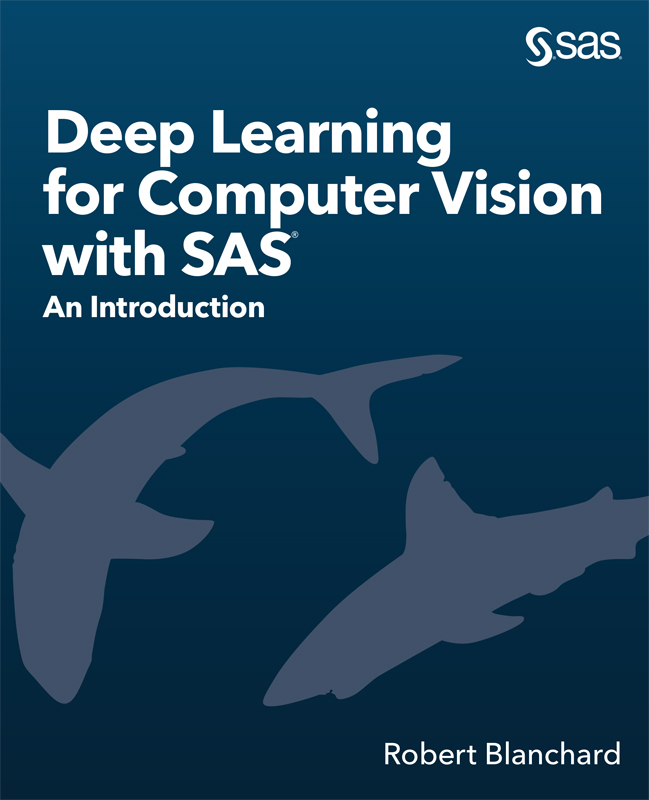
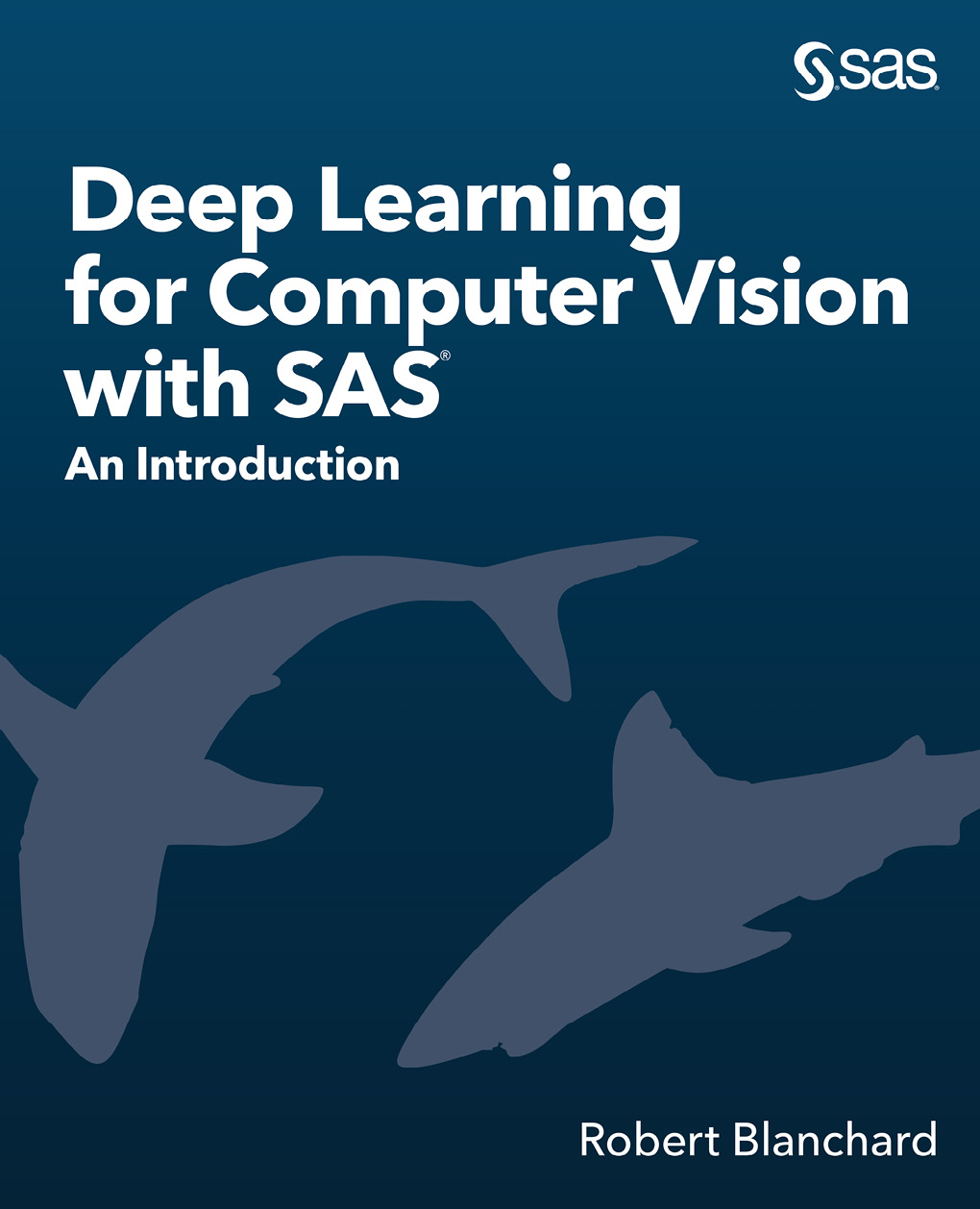
The correct bibliographic citation for this manual is as follows: Blanchard, Robert 2020. Deep Learning for Computer Vision with SAS : An Introduction . Cary, NC: SAS Institute Inc.
Deep Learning for Computer Vision with SAS: An Introduction
Copyright 2020, SAS Institute Inc., Cary, NC, USA
ISBN 978-1-64295-972-7 (Hardcover)
ISBN 978-1-64295-915-4 (Paperback)
ISBN 978-1-64295-916-1 (PDF)
ISBN 978-1-64295-917-8 (EPUB)
ISBN 978-1-64295-918-5 (Kindle)
All Rights Reserved. Produced in the United States of America.
For a hard copy book: No part of this publication may be reproduced, stored in a retrieval system, or transmitted, in any form or by any means, electronic, mechanical, photocopying, or otherwise, without the prior written permission of the publisher, SAS Institute Inc.
For a web download or e-book: Your use of this publication shall be governed by the terms established by the vendor at the time you acquire this publication.
The scanning, uploading, and distribution of this book via the Internet or any other means without the permission of the publisher is illegal and punishable by law. Please purchase only authorized electronic editions and do not participate in or encourage electronic piracy of copyrighted materials. Your support of others rights is appreciated.
U.S. Government License Rights; Restricted Rights: The Software and its documentation is commercial computer software developed at private expense and is provided with RESTRICTED RIGHTS to the United States Government. Use, duplication, or disclosure of the Software by the United States Government is subject to the license terms of this Agreement pursuant to, as applicable, FAR 12.212, DFAR 227.7202-1(a), DFAR 227.7202-3(a), and DFAR 227.7202-4, and, to the extent required under U.S. federal law, the minimum restricted rights as set out in FAR 52.227-19 (DEC 2007). If FAR 52.227-19 is applicable, this provision serves as notice under clause (c) thereof and no other notice is required to be affixed to the Software or documentation. The Governments rights in Software and documentation shall be only those set forth in this Agreement.
SAS Institute Inc., SAS Campus Drive, Cary, NC 27513-2414
June 2020
SAS and all other SAS Institute Inc. product or service names are registered trademarks or trademarks of SAS Institute Inc. in the USA and other countries. indicates USA registration.
Other brand and product names are trademarks of their respective companies.
SAS software may be provided with certain third-party software, including but not limited to open-source software, which is licensed under its applicable third-party software license agreement. For license information about third-party software distributed with SAS software, refer to http://support.sas.com/thirdpartylicenses .
Contents
About This Book
What Does This Book Cover?
Deep learning is an area of machine learning that has become ubiquitous with artificial intelligence. The complex, brain-like structure of deep learning models is used to find intricate patterns in large volumes of data. These models have heavily improved the performance of general supervised models, time series, speech recognition, object detection and classification, and sentiment analysis.
SAS has a rich set of established and unique capabilities with regard to deep learning. This book introduces the basics of deep learning with a focus on computer vision. The book details and demonstrates how to build computer vision models using SAS software. Both the art and science behind model building is covered.
Is This Book for You?
The general audience for this book should be either SAS or Python programmers with knowledge of traditional machine learning methods.
What Should You Know about the Examples?
This book includes tutorials for you to follow to gain hands-on experience with SAS.
Software Used to Develop the Books Content
To follow along with the demos in this book, you will need the following software:
SAS Viya (VDMML)
SAS Studio
Python
Example Code and Data
You can access the example code and data for this book by linking to its author page at https://support.sas.com/blanchard or on GitHub at https://github.com/sassoftware .
We Want to Hear from You
SAS Press books are written by SAS Users for SAS Users. We welcome your participation in their development and your feedback on SAS Press books that you are using. Please visit sas.com/books to do the following:
Sign up to review a book
Recommend a topic
Request information on how to become a SAS Press author
Provide feedback on a book
Do you have questions about a SAS Press book that you are reading? Contact the author through .
SAS has many resources to help you find answers and expand your knowledge. If you need additional help, see our list of resources: sas.com/books .
Learn more about this author by visiting his author page https://support.sas.com/blanchard . There you can download free book excerpts, access example code and data, read the latest reviews, get updates, and more.
About The Author

Robert Blanchard is a Senior Data Scientist at SAS where he builds end-to-end artificial intelligence applications. He also researches, consults, and teaches machine learning with an emphasis on deep learning and computer vision for SAS. Robert has authored several professional courses on topics including neural networks, deep learning, and optimization modeling. Before joining SAS, Robert worked under the Senior Vice Provost at North Carolina State University, where he built models pertaining to student success, faculty development, and resource management. While working at North Carolina State University, Robert also started a private analytics company that focused on predicting future home sales. Prior to working in academia, Robert was a member of the research and development group on the Workforce Optimization team at Travelers Insurance. His models at Travelers focused on forecasting and optimizing resources. Robert graduated with a masters degree in Business Analytics and Project Management from the University of Connecticut and a masters degree in Applied and Resource Economics from East Carolina University.
Learn more about this author by visiting his author page https://support.sas.com/blanchard . There you can download free book excerpts, access example code and data, read the latest reviews, get updates, and more.
Chapter 1: Introduction to Deep Learning
Introduction to Neural Networks
Artificial neural networks mimic key aspects of the brain, in particular, the brains ability to learn from experience. In order to understand artificial neural networks, we first must understand some key concepts of biological neural networks, in other words, our own biological brains.
A biological brain has many features that would be desirable in artificial systems, such as the ability to learn or adapt easily to new environments. For example, imagine you arrive at a city in a country that you have never visited. You dont know the culture or the language. Given enough time, you will learn the culture and familiarize yourself with the language. You will know the location of streets, restaurants, and museums.
Font size:
Interval:
Bookmark:
Similar books «Deep Learning for Computer Vision with SAS»
Look at similar books to Deep Learning for Computer Vision with SAS. We have selected literature similar in name and meaning in the hope of providing readers with more options to find new, interesting, not yet read works.
Discussion, reviews of the book Deep Learning for Computer Vision with SAS and just readers' own opinions. Leave your comments, write what you think about the work, its meaning or the main characters. Specify what exactly you liked and what you didn't like, and why you think so.

